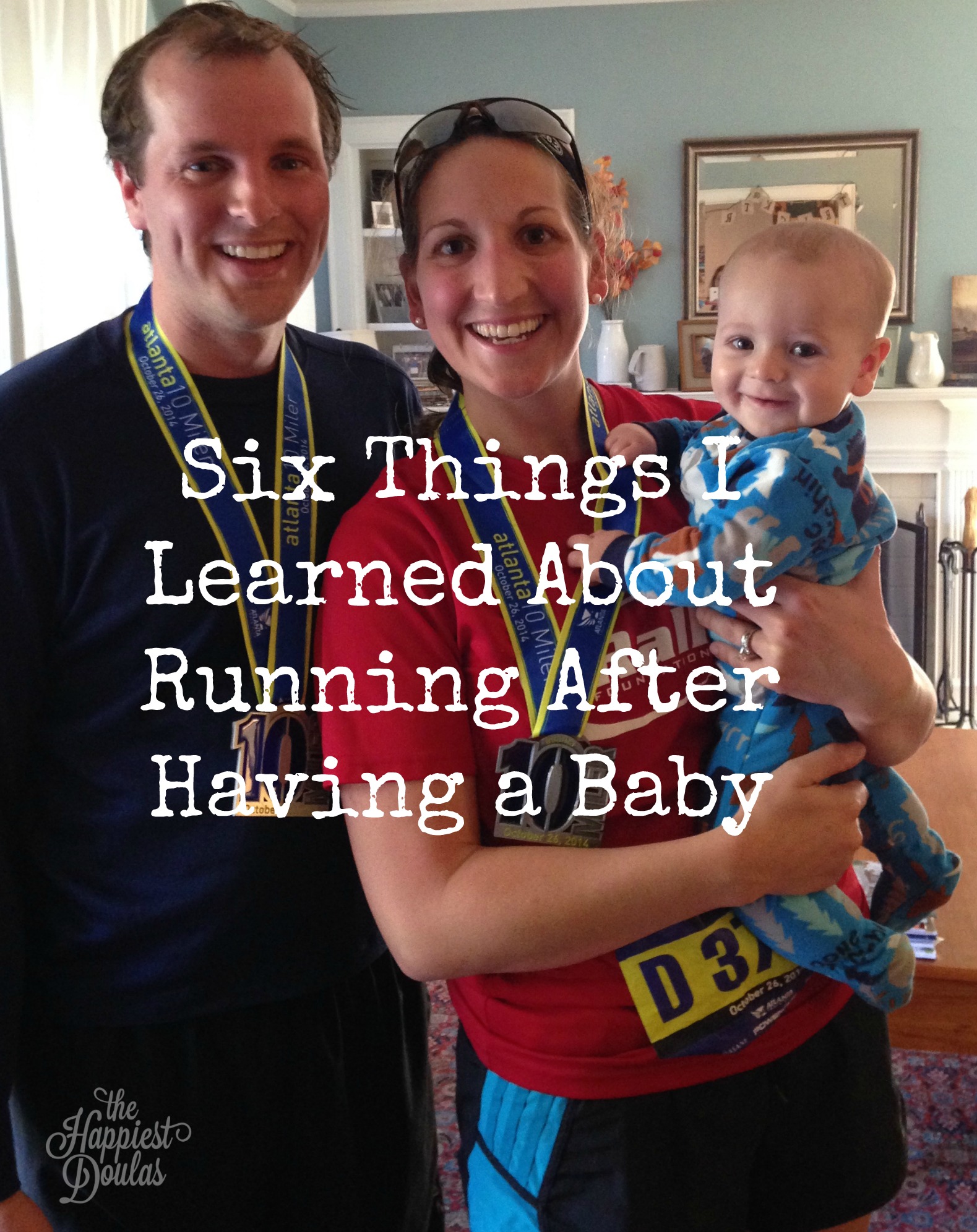What Every Female Runner Should Know Postpartum
/by Dr. Kate Mihevc Edwards
I am a mom, a runner and a triathlete. I have the benefit of being a physical therapist (PT) that specializes in treating runners and triathletes and I work in an office with two knowledgeable pelvic health PTs. My son just turned one and I, too, am still re-learning my body. Over and over I have heard friends and patients talk about wearing a pad when they run because of leaking or getting a stress fracture while they are breastfeeding. I hear about how exhausted they are how hard they are working to get their abs back to pre-pregnancy form.
In 2013, Running USA reported that female runners are at an all time high with 8.6 million female race finishers nationwide and females accounting for 56% of all race finishers. With over 4 million babies born in the U.S. each year, I wonder how many of these women have had babies and how many have had questions about how to return to running after their babies.
Whether you were a running before you had a baby or not, running is an attractive exercise option for moms. It is much easier to lace up your shoes run out the door than going to a gym. For me, running is a gift; it allows me a few minutes of alone time as well as some needed freedom by taking my son with me on the run. A recent study even found that women who ran while breastfeeding had a significantly lower incidence of postpartum depression.*
It is difficult to find information or resources for women when we return to running or start running postpartum. Most women have no idea where to start, what to expect, how their body should feel and what is/isn’t normal. By addressing these issues and educating ourselves and others about how our bodies change during the months after childbirth, we can significantly reduce the potential for injury.
Things I’ve learned along my journey back to running
Don’t start running too soon! Believe me I wanted to run as soon as possible, I bargained with myself nearly every day, but in the end I took the advice of one of my colleagues and waited 8 weeks. I was very glad I did. Friends of mine that did not wait long enough have had a more difficult time finding their stride and a few have even been injured. A recent article reported one quarter of the women in their study resumed running two or fewer weeks postpartum.* The body is undergoing rapid, tremendous change during the first 2-6 months postpartum. Starting too soon may put you at risk for injury.
I recommend you consult 2 professionals before returning to running:
Your Physician. Your Ob/Gyn will be able to tell you whether your body is healing appropriately and whether it is safe to return to running. Women who deliver vaginally may be able to return to running sooner than those who undergo a Cesarian Section.
A Pelvic Health Physical Therapist. I did this and suggest all of my friends to do this too. Being a PT I knew how important it was and wanted to go right away, but was told to wait until approximately 6-8 weeks postpartum. Even though I am a PT and know my body very well I still learned so much. Your therapist will be able to assess how your muscles are functioning and can guide you on how to return to exercise safely. The pelvic floor is the “floor of your core.” By keeping this muscle strong and functioning well, it will help you stay injury free. If it is not working then it will set you up for issues later on.
Returning to running after a baby is hard.
You are exhausted, you are heavier, and your breasts hurt. I had to run with two sports bras just to be comfortable. No matter what kind of runner you were before your munchkin was born take it easy on yourself. Your body did an amazing thing; give it a break. You will get there.
I have completed several triathlons, 14 marathons including 3 Boston marathons under my belt. When I started running again I was so excited and defeated all at once. I was running again, yet I ran 4:00 minutes/mile slower than usual, for a long time. Almost a year later, and still breastfeeding, my feet are beginning to move quickly again. It is okay to pace yourself, go slow and work your way back to your pre-pregnancy PR. Enjoy the time you have to exercise and all the benefit it brings; the speed will come.
“Leaking is common, but NOT normal.”
This is one of my favorite quotes from a colleague of mine, Blair Green, PT who specializes in treating woman and the pelvic floor. When I went to my postpartum yoga class everyone was talking about how they would pee accidentally. I couldn’t believe how common and accepted this was. Of course I was the obnoxious one screaming NO! It is not okay! I gave out a lot of Blair’s business cards and got a lot of words of thanks later.
If you are leaking when you cough, sneeze, jump or run make an appointment with a local pelvic health PT. There is no reason you should just deal with this. A good pelvic health PT can screen your musculoskeletal system and identify areas of impairment in muscle length, strength and function that may be holding you back from full return to running.
You are at higher risk for stress fractures when you are breastfeeding.
I tell you this so that you are aware. It makes sense - you are producing food for another human. Your body will choose to make milk over maintaining your bone health. You need to make sure you are getting enough calories and not running too much too soon.
It is far worse to get a stress fracture and not be able to run than it is to ease into running and stay healthy. Believe me you do not want to be in a walking boot trying to chase a toddler or carrying a baby in a car seat.
Have you ever heard of a diastasis recti?
Essentially it is a split in the abdominal wall muscles. Some women have them and do not realize it and for others it is very noticeable. If you feel a vertical gap between your abs at, above, or below your belly button, especially when engaging your abdominals it is possible you have one. There have been studies that link having a diastasis to stress incontinence in women even years after having their babies.**
Doing sit-ups and a lot of abdominal exercises can make this condition worse, not better. Again this is another issue that can be addressed by a PT and possibly a knowledgeable Pilates instructor. If you choose to try and address this with Pilates it is important that your instructor truly understands and has experience working with postpartum women with diastasis. It would be ideal that your PT clear you to participate in Pilates first.
Maintaining good running form while pushing a stroller is extremely difficult.
I help people improve their running form all day long, everyday and it is still difficult for me to push the stroller with good form. Ideally, you want to do your best to maintain a fairly normal stride and good posture.
Try not to lean forward from the hips when pushing the stroller in front of you. I notice this happens more when people are going uphill. Think about keeping your rib cage stacked over your pelvis and breathing for optimal stability. If you are pushing the stroller with two hands hold onto the handle on the outside edge in order to keep you thumbs towards the sky and elbows towards the ground. If you are pushing with one arm and swinging the other be sure to switch back and forth between sides periodically.
The bottom line is in order to carry, deliver and nourish a child, your body has to change and adapt. These changes can affect your running and put you at risk for injury but they don’t have to if you are aware of the common issues postpartum women face. So next time you hear your friend talking about peeing when they run or her say she is still breastfeeding but wants to get back to her 30-40 miles/week ASAP talk about it- the more we talk about the common issues women have the more “normal” it is to address them. My goal is always to keep runners running. Be smart and utilize your resources around you. Running has been shown to improve mood, cognition and has extensive health benefits, so keep running ladies! I hope to see you out there looking strong and kicking butt as you push your BOB or double BOB up those hills!
References:
*Tenforde, A.S., et al (2015) Running Habits of Competitive Runners During Pregnancy and Breastfeeding. Sports Health a Multidisciplinary Approach, 7(2) 172-176.
**Spitznagle TM, Leong FC, van Dillen LR 2007 Prevalence of diastasis recti abdominis in a urogynecological patient population. Int Urogynecology
Dr. Edwards is a Physical Therapist that specializes in treating runners and triathletes. She is the co-founder of Precision Performance Consulting LLC where she performs comprehensive running analysis for runners of all ages and abilities. She is an adjunct professor in the Emory University Physical Therapy School of Medicine and works as a Physical Therapist at Back 2 Motion Physical Therapy in Atlanta, GA.






